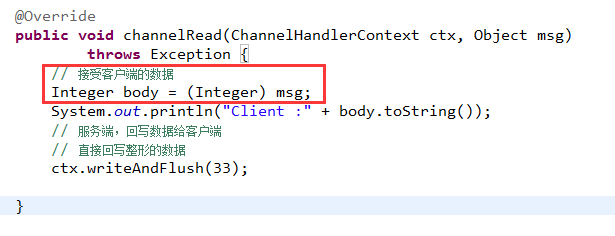Netty之實現自定義簡單的編解碼器一(MessageToByteEncoder和ByteToMessageDecoder)
阿新 • • 發佈:2019-01-26
1、關於自定義編碼器的簡介
在這裡實現的編解碼器很簡單。編碼器的功能實現的是,int--->byets的編碼;解碼器實現的是,bytes--->int的解碼。
2、編碼器的實現
3、解碼器的實現import io.netty.buffer.ByteBuf; import io.netty.channel.ChannelHandlerContext; import io.netty.handler.codec.MessageToByteEncoder; public class IntegerToByteEncoder extends MessageToByteEncoder<Integer> { @Override protected void encode(ChannelHandlerContext ctx, Integer msg, ByteBuf out) throws Exception { System.out.println("IntegerToByteEncoder encode msg is " + msg); out.writeInt(msg); } }
4、使用編解碼器的步驟import java.util.List; import io.netty.buffer.ByteBuf; import io.netty.channel.ChannelHandlerContext; import io.netty.handler.codec.ByteToMessageDecoder; public class ByteToIntegerDecoder extends ByteToMessageDecoder { @Override protected void decode(ChannelHandlerContext ctx, ByteBuf in, List<Object> out) throws Exception { // Check if there are at least 4 bytes readable if (in.readableBytes() >= 4) { int n = in.readInt(); System.out.println("ByteToIntegerDecoder decode msg is " + n); // Read integer from inbound ByteBuf // add to the List of decodec messages out.add(n); } } }
4.1 加入編解碼器
4.2 傳送資訊,編碼方式的改變
因為加入了int--->bytes的編碼器。所以,再發送資料的時候,可以直接傳送Integer型別的資料。不需要在手動的,將Integer利用Unpooled工具類轉換為ByteBuf型別在傳送。
4.2.1 使用編碼器之前的程式碼方式
4.2.1 使用編碼器之後的程式碼方式
4.3 接受資訊,編碼方式的改變
因為加入了bytes--->int的解碼器。所以,可以將訊息轉換為Integer型別處理。
4.3.1 沒加入解碼器前的程式碼方式
4.3.2 加入瞭解碼器後的程式碼方式
5、服務端的實現
import io.netty.bootstrap.ServerBootstrap;
import io.netty.channel.ChannelFuture;
import io.netty.channel.ChannelInitializer;
import io.netty.channel.ChannelOption;
import io.netty.channel.EventLoopGroup;
import io.netty.channel.nio.NioEventLoopGroup;
import io.netty.channel.socket.SocketChannel;
import io.netty.channel.socket.nio.NioServerSocketChannel;
public class Server {
public void bind(int port) throws Exception {
// 伺服器執行緒組 用於網路事件的處理 一個用於伺服器接收客戶端的連線
// 另一個執行緒組用於處理SocketChannel的網路讀寫
EventLoopGroup bossGroup = new NioEventLoopGroup();
EventLoopGroup workerGroup = new NioEventLoopGroup();
try {
// NIO伺服器端的輔助啟動類 降低伺服器開發難度
ServerBootstrap serverBootstrap = new ServerBootstrap();
serverBootstrap.group(bossGroup, workerGroup)
.channel(NioServerSocketChannel.class)// 類似NIO中serverSocketChannel
.option(ChannelOption.SO_BACKLOG, 1024)// 配置TCP引數
.option(ChannelOption.SO_BACKLOG, 1024) // 設定tcp緩衝區
.option(ChannelOption.SO_SNDBUF, 32 * 1024) // 設定傳送緩衝大小
.option(ChannelOption.SO_RCVBUF, 32 * 1024) // 這是接收緩衝大小
.option(ChannelOption.SO_KEEPALIVE, true) // 保持連線
.childHandler(new ChildChannelHandler());// 最後繫結I/O事件的處理類
// 處理網路IO事件
// 伺服器啟動後 繫結監聽埠 同步等待成功 主要用於非同步操作的通知回撥 回撥處理用的ChildChannelHandler
ChannelFuture f = serverBootstrap.bind(port).sync();
System.out.println("Server啟動");
// 等待服務端監聽埠關閉
f.channel().closeFuture().sync();
} finally {
// 優雅退出 釋放執行緒池資源
bossGroup.shutdownGracefully();
workerGroup.shutdownGracefully();
System.out.println("伺服器優雅的釋放了執行緒資源...");
}
}
/**
* 網路事件處理器
*/
private class ChildChannelHandler extends ChannelInitializer<SocketChannel> {
@Override
protected void initChannel(SocketChannel ch) throws Exception {
// 增加自定義的編碼器和解碼器
ch.pipeline().addLast(new IntegerToByteEncoder());
ch.pipeline().addLast(new ByteToIntegerDecoder());
// 服務端的處理器
ch.pipeline().addLast(new ServerHandler());
}
}
public static void main(String[] args) throws Exception {
int port = 9998;
new Server().bind(port);
}
}import io.netty.channel.ChannelHandlerAdapter;
import io.netty.channel.ChannelHandlerContext;
public class ServerHandler extends ChannelHandlerAdapter {
@Override
public void channelRead(ChannelHandlerContext ctx, Object msg)
throws Exception {
// 接受客戶端的資料
Integer body = (Integer) msg;
System.out.println("Client :" + body.toString());
// 服務端,回寫資料給客戶端
// 直接回寫整形的資料
ctx.writeAndFlush(33);
}
@Override
public void exceptionCaught(ChannelHandlerContext ctx, Throwable cause)
throws Exception {
ctx.close();
}
@Override
public void channelReadComplete(ChannelHandlerContext ctx) throws Exception {
ctx.flush();
}
}
import io.netty.bootstrap.Bootstrap;
import io.netty.channel.ChannelFuture;
import io.netty.channel.ChannelInitializer;
import io.netty.channel.ChannelOption;
import io.netty.channel.EventLoopGroup;
import io.netty.channel.nio.NioEventLoopGroup;
import io.netty.channel.socket.SocketChannel;
import io.netty.channel.socket.nio.NioSocketChannel;
public class Client {
/**
* 連線伺服器
*
* @param port
* @param host
* @throws Exception
*/
public void connect(int port, String host) throws Exception {
// 配置客戶端NIO執行緒組
EventLoopGroup group = new NioEventLoopGroup();
try {
// 客戶端輔助啟動類 對客戶端配置
Bootstrap b = new Bootstrap();
b.group(group)//
.channel(NioSocketChannel.class)//
.option(ChannelOption.TCP_NODELAY, true)//
.handler(new ClientChannelHandler());//
// 非同步連結伺服器 同步等待連結成功
ChannelFuture f = b.connect(host, port).sync();
// 傳送訊息
Thread.sleep(1000);
f.channel().writeAndFlush(777);
f.channel().writeAndFlush(666);
Thread.sleep(2000);
f.channel().writeAndFlush(888);
// 等待連結關閉
f.channel().closeFuture().sync();
} finally {
group.shutdownGracefully();
System.out.println("客戶端優雅的釋放了執行緒資源...");
}
}
/**
* 網路事件處理器
*/
private class ClientChannelHandler extends
ChannelInitializer<SocketChannel> {
@Override
protected void initChannel(SocketChannel ch) throws Exception {
// 增加自定義的編碼器和解碼器
ch.pipeline().addLast(new IntegerToByteEncoder());
ch.pipeline().addLast(new ByteToIntegerDecoder());
// 客戶端的處理器
ch.pipeline().addLast(new ClientHandler());
}
}
public static void main(String[] args) throws Exception {
new Client().connect(9998, "127.0.0.1");
}
}
import io.netty.channel.ChannelHandlerAdapter;
import io.netty.channel.ChannelHandlerContext;
import io.netty.util.ReferenceCountUtil;
public class ClientHandler extends ChannelHandlerAdapter {
@Override
public void channelRead(ChannelHandlerContext ctx, Object msg)
throws Exception {
try {
Integer body = (Integer) msg;
System.out.println("Client :" + body.toString());
// 只是讀資料,沒有寫資料的話
// 需要自己手動的釋放的訊息
} finally {
ReferenceCountUtil.release(msg);
}
}
@Override
public void exceptionCaught(ChannelHandlerContext ctx, Throwable cause)
throws Exception {
ctx.close();
}
}
Server端
Server啟動
ByteToIntegerDecoder decode msg is 777
ByteToIntegerDecoder decode msg is 666
Client :777
IntegerToByteEncoder encode msg is 33
Client :666
IntegerToByteEncoder encode msg is 33
ByteToIntegerDecoder decode msg is 888
Client :888
IntegerToByteEncoder encode msg is 33IntegerToByteEncoder encode msg is 777
IntegerToByteEncoder encode msg is 666
ByteToIntegerDecoder decode msg is 33
ByteToIntegerDecoder decode msg is 33
Client :33
Client :33
IntegerToByteEncoder encode msg is 888
ByteToIntegerDecoder decode msg is 33
Client :3310、原始碼下載





